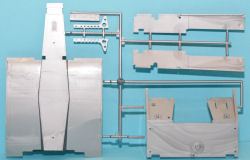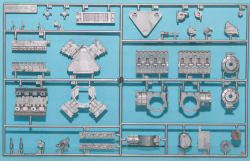
Tamiya 1/12 Lotus Type 78 Kit First Look
By Michael Benolkin
| Date of Review | July 2008 | Manufacturer | Tamiya |
|---|---|---|---|
| Subject | Lotus Type 78 | Scale | 1/12 |
| Kit Number | 12037 | Primary Media | Styrene, PE |
| Pros | Exquisite detail | Cons | Nothing noted |
| Skill Level | Intermediate | MSRP (USD) | $147.00 |
First Look
 |
 |
 |
 |
 |
 |
 |
 |
 |
 |
 |
 |
 |
 |
 |
The Lotus racing team has long history of designing thoroughbred Formula One racing cars under the direction of founder Colin Chapman. Each succeeding design pushed the state of the art in racing performance to the next level. From its first days in the mid-1950s with the Mark 6, Team Lotus attracted leading drivers and sponsors in its quest for racing excellence.
The Lotus 72 introduced their wedge-shaped body housing a mid-mounted V8 Ford engine, and while it performed well through several design changes, the car was eventually outclassed by the Ferrari 312. The Lotus designers tried unsuccessfully to develop a replacement to the 72, and even though subsystem improvements were achieved, none of them led to a major improvement in performance.
Chief designer Ralph Bellamy and his team took a new approach to the design through a white paper written by Chapman regarding low drag air penetration. Bellamy's team applied the rules of fluid dynamics to a modified 72 to create the overall effect of an inverted wing. The faster the car travelled, the greater the down-force on the car which translated into greater stability and traction at higher speeds. Additional aerodynamic innovations aided in maintaining the aerodynamic effects through a wider range of racing conditions. When the car was introduced in 1977, the results were impressive and the other racing teams scrambled to create a car that could compete with the Type 78.
Tamiya has a very notable series of kits in their 1/12 racing car line, all of which are very magnificent in their design and assembly. One of these kits was the Type 78 'John Player Special' which was driven by several of Team Lotus' top gun drivers into the record books. This kit replicated the gloss black body with gold pin striping and markings denoting its John Player backing. This kit has been out of production for some time now.
Tamiya has reissued this kit with a few updates. While the plastic parts are identical to the first release, this kit adds a fret of photo-etched details and three decal marking options from the 1977 and 1978 seasons. The kit is rendered on 12 styrene parts trees, six of which are molded in black styrene, five in silver styrene, and one in chrome-plated styrene. One tree of vinyl parts, including the driver's seat and four rubber tires round out the original kit.
You'll note that this kit has very few large parts. This is because Tamiya has recreated the same modules and subsystems in the car, many of which are accessible through removable body panels, similar to the full-scale racer.
Like any high performance fighter, this kit starts its assembly off in the cockpit. Unlike most fighters however, you'll quickly note how the driver's pedals are mounted on the front suspension frame while his seat is fitted into a recess in the fuel tank. Like a fighter aircraft, no space goes wasted in providing the most capability in the lowest drag airframe. As you run through these assembly steps, you'll appreciate just how much these designers have fit inside this small airframe.
You know that in 1/12 scale, far more detail is visible than in the typical aircraft or even auto (1/24-1/25) scales, and Tamiya does not disappoint in this department. The Ford V8 engine is detailed from its intake manifolds to the intricate exhaust headers. The ignition wiring and fuel injection plumbing are all here.
The photo-etched parts add addition fidelity over the original issue with disc brake surfaces, intricately detailed quick-release safety harness, and radiator grilles nicely rendered.
Speaking of details, the kit does feature working suspension, steerable front wheels, and the removable cowl panels mentioned above to show off the detail inside the car.
In this release, three cars are rendered here:
- No.5 Mario Andretti, 1977 British Grand Prix
- No.6 Gunnar Nilsson, 1977 British Grand Prix
- No.6 Ronnie Peterson, 1978 British Grand Prix Qualifying Race
This kit represents a major step in the evolution of Formula 1 racing, and while it didn't take long for the other teams to catch up to this hot racer, the Type 78 dominated the 1977 season and performed well into 1978. If you 'feel the need for speed', this is one car that should be on your short-list of hot projects.
My sincere thanks to HobbyLink Japan for this review sample!







